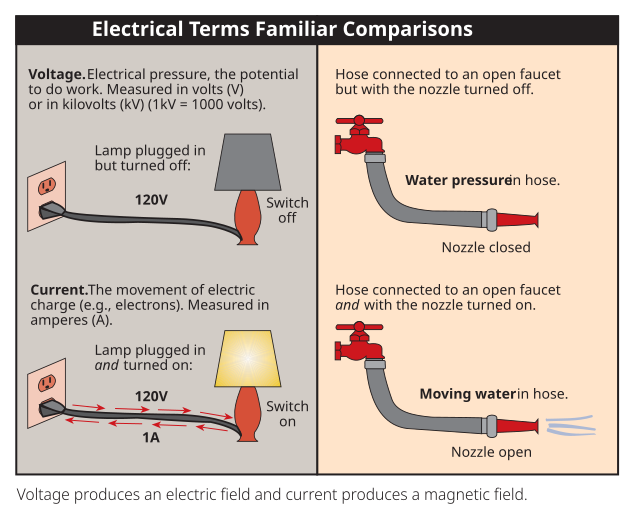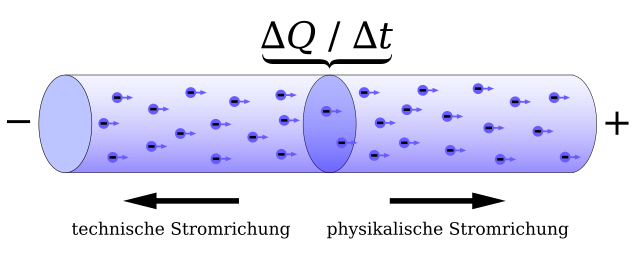Voltage is one of the core concepts in electricity. Whether you’re powering a small LED or designing a home circuit, understanding voltage is essential. In this article, we’ll break down the basics of voltage, explain what potential difference really means, show you how to measure voltage, explore the difference between AC and DC voltage, and explain why voltage levels vary in different parts of the world.
What Is Voltage?
Voltage is the force that drives electrons through a circuit. Without it, electrons still move between atoms, but they drift randomly and don’t generate any useful current. When we apply voltage, these free electrons begin to move in the same direction—creating electrical current.

An easy way to understand voltage is to think of it like pressure in a water pipe. If you have a large tank completely filled with water, the weight of the water creates strong pressure at the bottom of the pipe. If the tank is only half full, there’s less pressure.
Now, if you open a valve at the bottom of the pipe, water will begin to flow. The tank with more pressure will push water faster and more forcefully. Electricity works the same way: the higher the voltage, the more current can flow through the circuit.
But here’s something important: voltage can still exist even if nothing is flowing. Just like a closed valve still holds water pressure behind it, a battery or power supply can have voltage even when the circuit is open and no current is moving.
This leads to the concept of potential difference — which refers to the difference in electrical pressure between two points in a circuit. It’s like having two water tanks at different heights. Water will only flow if there’s a difference in height between them. If both tanks are at the same level, there’s no flow. But if one is higher, water flows from the higher to the lower tank, and that flow can do work.
In the same way, if there’s a voltage difference between two points in a circuit and we close the path (e.g. flip a switch), electrons will begin to flow. That flow can power a motor, light a bulb, or charge a device. Voltage, or potential difference, is what makes this possible—even before any current starts to move.
Voltage vs. Current
Voltage and current are two fundamental but distinct electrical concepts. Though closely related, they describe different behaviors in a circuit.
Voltage (measured in volts) is the electrical potential difference between two points. It’s the “push” that motivates electrons to move.
Current (measured in amperes or amps) is the actual flow of electric charge—the movement of electrons through a conductor.
To visualize this, return to the water analogy:
Voltage is like the pressure in a pipe.
Current is the amount of water that actually flows when the valve is open.
You can have voltage without current—just like a sealed pipe can have pressure without any water flow. Once the valve is opened and a path is available, water flows. Similarly, electrical current only flows when there’s a complete circuit that allows electrons to move.
This relationship is captured by Ohm’s Law:
<strong>V = I × R</strong>Where:
- V is voltage (volts)
- I is current (amperes)
- R is resistance (ohms)
From this equation, we can see:
- Increasing voltage (with constant resistance) increases current.
- Increasing resistance (with constant voltage) decreases current.
- In short, voltage is the cause, and current is the effect.
Direct Current (DC) Voltage
Direct Current (DC) voltage refers to a constant electrical potential that flows in one direction. In DC systems, the polarity stays fixed: electrons flow steadily from the negative terminal to the positive terminal of the power source.
The defining feature of DC voltage is its stability. It doesn’t fluctuate—it remains at a steady level. If you graph it, DC appears as a straight, horizontal line.
DC voltage is commonly provided by:
- Batteries (e.g. AA, AAA, lithium-ion)
- Power adapters and USB ports
- Solar panels
- DC bench power supplies
Typical DC voltage levels include:
- 1.5V (AA battery)
- 3.3V / 5V / 9V / 12V / 24V (electronics, sensors, modules)
- 5V USB power
- 12V automotive systems
DC is widely used in low-voltage electronics because of its reliability and simplicity. It powers microcontrollers, sensors, LED strips, and most household gadgets. However, DC is not ideal for long-distance transmission due to energy loss in wires. That’s why AC is used for the power grid, while DC is used inside devices.
Alternating Current (AC) Voltage
Alternating Current (AC) voltage behaves very differently from DC. In AC systems, the direction of current flow reverses periodically. Instead of a steady flow in one direction, the voltage alternates from positive to negative in a repeating cycle.
This changing pattern forms a sine wave when plotted on a graph—smooth, rising above and below zero. The number of complete cycles per second is the frequency, measured in hertz (Hz).
Standard AC frequencies:
- 50 Hz – Europe, Asia, Africa
- 60 Hz – North America, parts of South America and Asia
Typical voltage levels:
- 100V – 127V – USA, Canada, Japan
- 220V – 240V – Europe, Australia, most of Asia
AC voltage is used in power grids because it can be easily stepped up or down using transformers. High-voltage AC can be transmitted efficiently over long distances and then reduced to safe levels for homes and buildings.
Household appliances, lighting systems, and industrial equipment all run on AC. However, because AC voltage constantly fluctuates, it’s not ideal for powering sensitive electronics directly. Most devices, like phones and laptops, include AC-to-DC converters that transform the wall power into stable DC voltage.
Why Voltage Varies Around the World
The voltage and frequency of electricity differ across countries, and it all goes back to how power systems were developed historically. In the early days of electricity, there was no global standard. Different companies and engineers chose different voltages and frequencies based on what suited their needs at the time.
Over time, these early choices became fixed standards. For example:
Most of the world adopted 220–240V at 50 Hz
North America and parts of Asia use 100–127V at 60 Hz
This is why electrical devices made in one region may not work properly in another. For example:
A 110V hair dryer plugged into a 220V outlet may burn out.
A 220V appliance plugged into a 110V socket may not turn on, or run very weakly.
Fortunately, many modern devices are built with universal power supplies that accept 100–240V and 50/60Hz, allowing them to work globally. Always check the label before plugging in any device abroad.
This is the foundation of understanding voltage in electrical systems. Whether you’re designing circuits or simply using everyday devices, knowing how voltage works is the first step toward using electricity safely and effectively.

